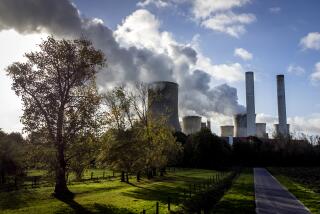UCI Study Shows Big Rise in Atmospheric Methane
- Share via
LOS ANGELES — Methane gas concentrations in the atmosphere have risen 11% since 1978, possibly speeding the seasonal loss of the protective ozone layer above Antarctica but blocking the same depletion over the rest of the Earth, according to UC Irvine researchers.
The gas is thought to speed the chemical breakdown of ozone caused by man-made chlorine compounds in polar regions, but winds and warmer temperatures elsewhere around the globe instead cause methane to attack the chlorine atoms, said UCI’s F. Sherwood Rowland, whose study will be published today in the journal Science.
“We’re changing the atmosphere in a rather rapid way. It’s hard to tell what the eventual consequences will be, but there are several ways it may have a strong impact on man,” said Rowland, who was part of the research team that first postulated a threat to the ozone layer more than a decade ago.
The study by Rowland and UCI chemist Donald R. Blake, funded by the National Aeronautics and Space Administration, also suggests that the atmospheric methane could aggravate global warming by the “greenhouse effect” but that the rate of increase of the gas slowed slightly during the last five years.
Origin of Most Methane
Methane is the major component of natural gas, but about 80% of atmospheric methane comes from decomposition in rice paddies, swamps and the guts of cows, with some contribution from wood digestion in termites, Rowland said.
People are responsible for increased methane levels because they are raising more cows and growing more rice than ever and chopping down tropical forests, which provides food for more termites, said atmospheric scientist Pat Zimmerman of the National Center for Atmospheric Research in Boulder, Colo.
Ozone is an air pollutant at low altitudes, but in the stratosphere it shields Earth’s surface from harmful solar ultraviolet radiation. Scientists say reduction of the ozone layer will cause more skin cancers and may trigger climate changes.
In 1974, Rowland and chemist Mario Molina first warned that the ozone layer was threatened by man-made chlorine compounds named chlorofluorocarbons, or CFCs, which are used as coolants in refrigerators and air conditioners, for making plastic foams and as spray-can propellants. The United States barred spray-can CFCs in 1978.
Mounting evidence indicates that CFCs are responsible for the worldwide loss of roughly 1% of Earth’s ozone shield and the formation of a hole in the ozone layer above Antarctica for a few months each year, starting every September.
Blake and Rowland said methane increases may worsen the ozone hole by aiding formation of ice clouds above Antarctica. Studies by Molina and others suggest that these clouds enhance chemical reactions that allow chlorine from CFCs to break down ozone.
As methane rises into the polar stratosphere, it breaks down and releases hydrogen, which combines with a chemical called hydroxyl to form water, which in turn freezes into clouds, Blake said.
But outside Antarctica, wind and higher temperatures prevent formation of stratospheric clouds, so methane attacks chlorine from CFCs, preventing the chlorine from destroying ozone, Blake said.
Molina, of NASA’s Jet Propulsion Laboratory in Pasadena, said the 11% methane increase “will make the ozone hole over Antarctica more severe. It will probably make the ozone depletion in the rest of the world less severe.”
He also said the increase “will make the greenhouse effect more severe.”
Researchers generally agree that by trapping solar heat like glass in a greenhouse, methane, carbon dioxide and other pollutants will probably warm Earth’s lower atmosphere by 3 to 5 degrees Fahrenheit by the year 2050.
Sea Levels Could Rise
They fear that this may cause crop-threatening droughts and partially melt polar ice caps, which could raise sea levels by up to 15 feet and threaten coastal cities.
Rowland and Blake also said that because increases in atmospheric methane reduce the amount of hydroxyl present, the atmosphere is losing its ability to cleanse itself of other pollutants. Hydroxyl reacts with many pollutants and removes them from the atmosphere.
Blake and Rowland collected air samples regularly from January, 1978, to September, 1987, at up to 60 locations around the Pacific to measure methane levels.
Earlier studies suggested that methane levels more than doubled during the previous 200 years. Blake and Rowland calculated that methane increases may have raised the amount of water vapor in the stratosphere by 28% since the 1940s and by 45% over the last two centuries.






